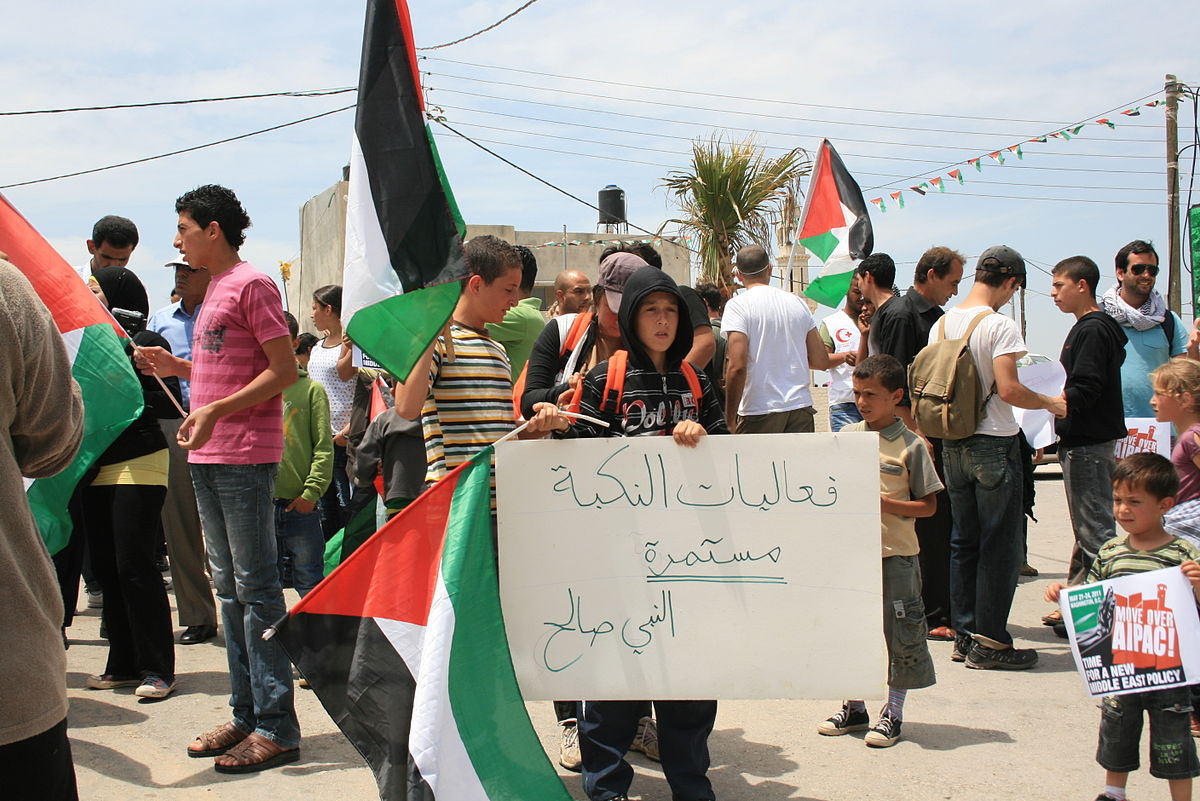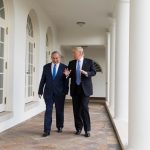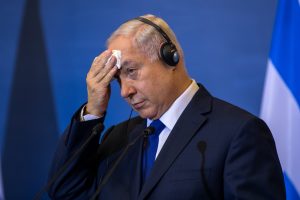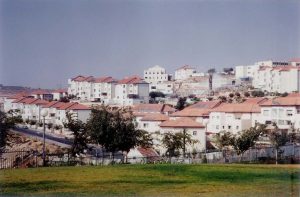by Lisa Goldman
A short video of 16-year-old Ahed Tamimi slapping an Israeli soldier has dominated the Israeli media for the past week, and received prominent coverage internationally as well. Ahed, a Palestinian girl from the West Bank village of Nabi Saleh, makes a big impression with her eye-catching mane of blonde hair, the fierce, intelligent expression in her blue eyes — and her fearlessness.
One of the most striking aspects of the immense discussion generated by the video is the near-binary contrast between what Israelis and their advocates see, and what everyone else sees.
For Israelis, one of their soldiers was provoked, almost unbearably, but still managed to rise above the situation. For almost everyone else, the video shows an unarmed adolescent — who could easily, based on her appearance, be an Israeli teenager shopping at the mall — bravely confronting an armed soldier in her own village. Even without knowing the circumstances, a fully-grown man in combat gear and carrying a powerful weapon refraining from hitting a much smaller, unarmed adolescent girl, seems not remarkably praiseworthy but rather a response predicated on basic humanity and ethics.
The Israeli media has, for the most part, promoted the army’s narrative about the incident — of a restrained and mature soldier who dealt admirably with a difficult and stressful situation involving enemy actors.
In the segment below, Yaron London, the host of an eponymously named primetime news magazine program on Channel 10, mirrors the perspective of the army. London’s guests are Or Heller, the station’s military affairs correspondent, and Jonathan (Yonatan) Pollak, a veteran anti-occupation activist:
The conversation between the three men is salutary because it provides real insight into the mentality of mainstream Israeli society. First we hear Or Heller, an experienced military affairs correspondent, repeating the army’s narrative. He expresses pride in the soldiers, makes the claim that the Tamimi family provoked the confrontation as a means of creating an anti-Israeli propaganda video, and asserts that the soldiers were only in the vicinity to prevent Palestinian residents from throwing rocks.
Yaron London, an intelligent and educated man who does, I am sure, identify as a liberal, fails to question Heller’s narrative. Both men are completely focused on the challenge those unarmed adolescent girls supposedly present to “their” soldiers, rather than on the actual violence that those soldiers visit upon the village week after week.
Jonathan Pollak was in Nabi Saleh when the incident occurred. Watch as he calmly provides the context, and note how shocked Heller and London are when Pollak refers to “your” army — rather than “our” army. (Pollak refused to serve, which is a radical act in Israel.)
This segment encapsulates the Achilles heel of the Israeli media — i.e., its willingness to report communiqués issued by the army as straight news, without any fact checking. Even though the Israeli security establishment has been caught lying on countless occasions, journalists who report for mainstream media outlets continue to accept without question the information they are given about events they neither witnessed nor verified independently.
Throughout the many months I attended Friday demonstrations in Nabi Saleh, I never saw a single reporter from an Israeli media outlet. And yet, during the drive home after those long and distressing days, the news presenter on Israel Radio would report that there had been “riots” in a West Bank village and that “our forces” responded with crowd control measures.
The Tamimi family has been demonstrating every Friday for about a decade, protesting the takeover of Nabi Saleh’s natural water spring by nearby settlers. As Bassem Tamimi once explained to me, in quite fluent Hebrew, the villagers said nothing when the army built the settlement of Halamish (originally Neve Tzuf) on their land. But when the settlers confiscated their spring, and the army then prevented the Tamimis from accessing it, Bassem and his extended family decided to draw a red line.
Every week they gather at the top of the hill inside their village, carrying flags and banners, and walk toward the road that separates them from the spring. The goal is simply to cross the road and walk to the spring. And every week, the army deploys security forces inside and around the village to stop the protesters from reaching their destination.
The way it works is this: at around noon, military vehicles enter the village and park at the bottom of its bisecting road. Security forces, heavily armed and wearing combat gear, descend from the vehicles, load their weapons, and wait. Sometimes they start shooting as soon as the demonstration begins, and sometimes they wait for a teenager to throw a stone in their direction before opening fire.
As Ben Ehrenreich notes in his New York Times Magazine article about Nabi Saleh, the army spokesperson told him there has never been a single case of a soldier being injured by a stone at those demonstrations. But over the past few years, soldiers have injured and killed several demonstrators.
In one now notorious incident, a soldier cracked open the rear door of his armored jeep as it was on its way out of the village, and shot a tear gas canister directly into the face of Ahed’s 21-year-old cousin Mustafa, killing him. No-one was ever censured or prosecuted for that act of murder.
These are just a few of the things I saw in Nabi Saleh.
Once, I was standing on the roof of a home with three teenage girls who lived there. We were watching the demonstration from a bit of a distance — maybe 150 meters. Suddenly one of the soldiers standing down the road pivoted in our direction, raised his weapon, aimed, and shot tear gas canisters directly at us. He shot another couple of canisters at the house, shattering the living room window. The older girl told me that her family had stopped replacing it every time the soldiers broke it; the glass had become too expensive.
I also witnessed soldiers deliberately blanketing a small house in tear gas until its occupants, coughing and retching long streams of mucus, were forced to emerge. They were two elderly women, wrinkled and bent over, and a young woman in her twenties.
I’ve seen soldiers grab crying children and shove them into military vehicles, pushing aside their screaming mothers.
I’ve seen soldiers grab a young woman by her arms and drag her like a sack of potatoes for several meters along an asphalt road so hot that it melted the rubber soles of my running shoes, before tossing her into a military vehicle and driving away.
I’ve had my ankles singed black when a security officer looked me straight in the eyes and threw a stun grenade at my legs.
Israeli army sharp-shooters regularly shoot unarmed demonstrators in Nabi Saleh with both rubber-coated steel bullets and live ammunition. They break into houses and drag people out, arresting them on the claim that they allowed demonstrators to hide in their garden.
And then I would go back to Tel Aviv and be told by my friends that I could not have seen what I saw, because “our soldiers” do not behave that way. Soon, I had to distance myself from those friends in order to keep my own emotions in check.
I write these sordid descriptions of what I saw at the demonstrations as a means of explaining how and why that place radicalized me. After Nabi Saleh I was, in a way, broken. The impact of the violence on my psyche was exhausting and traumatic, with long-lasting effects that I still experience today.
By the time I began going to Nabi Saleh, I had spent about four years reporting on what I saw in Gaza and the West Bank, and watching detachedly as my politics moved ever leftward from the liberal place in which they started, as a consequence of what I saw on the ground. But it was in Nabi Saleh that I lost the last remnants of what I would call — for lack of a word to describe my nostalgia for the idea of a state for the Jews — my Zionism.
My radicalization was not only a consequence of witnessing brutal violence perpetrated right in front of my eyes, by soldiers of the army that was supposed to protect me. It was also a result of my seeing the Tamimi family endure that violence week after week, seeing their relatives injured, arrested and killed, and still not coming to the conclusion that the price of resistance was too high. They simply refuse to submit.
Week after week, they welcome strangers into their home with kindness and hospitality. No one in Nabi Saleh ever expressed an ideological political opinion to me. They didn’t have to. The situation is clear; the actions of the Israeli government and security forces there are impossible to defend, on any level. And of course that is the source of the Tamimis’ strength — the knowledge that their cause is just, and that they are fighting it with ethical, nonviolent means.
The Tamimis clearly understand the power of social media. But they don’t manufacture those confrontations. In fact, I have never seen a video that comes remotely close to conveying the true brutality I saw in Nabi Saleh. Maybe you need to smell the tear gas and feel the smallness of the place to see how outrageous it is for soldiers to act as they do there: to, with a sense of entitlement, enter a village and break up a gathering of unarmed demonstrators; to kick open the doors of homes and drag off to jail unarmed people who pose no threat; to break into a house at 4 a.m., to roust a teenage girl from her bed and drag her off to jail, denying her even the right to be accompanied by a guardian.
I am sure Ahed understands very well the effect of her striking appearance. I am sure that Bassem Tamimi knows his genuine warmth and hospitality go a lot further in winning over hearts and minds than didactic political lectures ever could. With no money, and by sacrificing their own bodies and emotional well being, the Tamimis are drawing world attention to the hundreds of Palestinian children sitting in jail, who don’t have blonde hair and a strong, supportive family. They are showing the world what the occupation means, in tangible terms, to real people. They taught me, purely by example, what grassroots resistance means.
Is Israel, with all the money and manpower it pours into sophisticated advocacy campaigns via social media, really in a position to criticize the Tamimis for understanding how to publicize their own cause? As Jonathan Pollak says to Yaron London, the reason those Nabi Saleh videos make Israel look bad is because Israel is doing bad things.
Lisa Goldman has been writing about the Middle East in general, Israel-Palestine specifically for well over a decade. Since moving from Jaffa to Brooklyn a couple of years ago, she also writes about the US-Israel bilateral relationship and about the relationship between the American Jewish community and Israel. Republished, with permission, from +972 Magazine.






One crucial item was not mentioned in Lisa’s article or the commentators is that about one hour before Ahed’s confronting the soldiers, her cousin about 15 years old was shot in the face with a rubber coated bullet from a distance of about 3 meters. The bullet penetrated his skull. (He is now recovering). This is a good reason for Ahed to be enraged.
One of the commentator says to the Israeli thugs that they may one day regret their inhumane acts. Actually it is happening to a few.
I have a documentary video from many years ago, where 4 ex soldier girls talking about not being able to sleep properly and abusing alcohol and drugs due to what they witnessed.
Also a booklet published by an Israeli activist group, “Our harsh logic”, where 950 ex soldiers regretting about atrocities they done or saw.
A few years ago I read that Israeli soldier suicide is among the highest in the developed countries. Needless to say that its all hashed up.
In regard to the 2 soldiers who were calm in the face of being slapped and being praised all over. This has nothing to do with acting non violently, this is due to all soldiers having orders to be very careful when there are cameras, specially after about a year ago where a soldier went to a Palestinian youth lying on the floor bleeding from being shot and shot him in the head in front of many onlookers. This was filmed and made the rounds in many places.
No doubt in there were no cameras she would’ve been injured or dead.